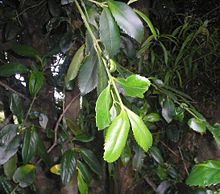Laurelia sempervirens
| Laurelia sempervirens | |
|---|---|
 |
|
| Scientific classification | |
| Kingdom: | Plantae |
| Clade: | Angiosperms |
| Clade: | Magnoliids |
| Order: | Laurales |
| Family: | Atherospermataceae |
| Genus: | Laurelia |
| Species: | L. sempervirens |
| Binomial name | |
|
Laurelia sempervirens (Ruiz & Pav.)Tul. |
|
| Synonyms | |
|
|
Laurelia sempervirens, commonly called Peruvian nutmeg, from mapuche: tihue, trihue, also called Chilean laurel or Chilean sassafras. It is a species of Evergreen tree in the family Atherospermataceae, formerly Monimiaceae family, in the southern hemisphere genus of plant Laurelia, not closely related to Lauraceae despite the similarity. It is endemic to Chile. It occurs 34–41° South Latitude. They require a warm subtropical to tropical climate that is cool but also frost-free or with only very slight winter frosts not below -4 °C, and with high summer heat, rainfall, and humidity. This is, the laurel forest habitat. The Tihue Growth best on well-drained, slightly acidic soils rich in organic matter.
The tihue is a large, ( up 30 m. tall to 2 m. diameter) evergreen laurifolia tree with smooth, yellow pale bark. The bark cracks when aging coming off in roughly circular plates. The wood and the leaves are strongly aromatic. The bright green leaves of the Chilean laurel are arranged in opposite pairs, and are oblong in shape, narrowed at the base. The leaves are leathery, shiny, and around 5 to 10 centimetres long and 2.5 to 5 centimetres wide. The serrated edges of the leaves help to distinguish this tree from the closely related Laureliopsis philippiana, which has more deeply toothed leaf margins. The tihue bears bundels of small yellow flowers this flowers are unisexuals or hermaphrodites. The fruit is a greenish achene with seeds bearing feathery anemophilous filaments. The seed is dispersed by the wind (anemochory).
Its wood is pale-yellowish, with growth rings little notorious and homogeneous and fine texture. It is threatened by habitat loss. It has been introduced into Spain and into Cornwall and planted in Sussex in the UK. The leaves of Laurelia sempervirens were used by Mapuche Amerindians for treating headache and as diuretic. [4]
...
Wikipedia

